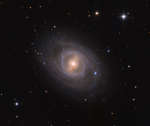
|
Astronomy Picture Of the Day (APOD)
 M95 with Supernova
M95 with Supernova
22.03.2012
Barred spiral galaxy M95 is about 75,000 light-years across, comparable in size to our own Milky Way and one of the larger galaxies of the Leo I galaxy group. In fact, it is part of a not quite so famous trio of Leo galaxies with neighbors M96 and M105, about 38 million light-years distant.
 Aurora Over Iceland
Aurora Over Iceland
21.03.2012
If you see a sky like this -- photograph it. Three nights ago in Iceland, an adventurous photographer (pictured) chanced across a sky full of aurora and did just that. Afterwards, by stitching together five smaller photographs, the entire aurora-lit sky was recreated in this 180-degree panorama taken from VatnajЖkull glacier.
 Evolution of the Moon
Evolution of the Moon
20.03.2012
What is the history of the Moon? The Moon was likely created from debris expelled when a Mars-sized object violently impacted the Earth about 4.5 billion years ago. Just after gravitationally condensing, as imagined above, the glowing-hot surface of the Moon cooled and cracked.
 Sunspot Group 1429 and the Distant Sun
Sunspot Group 1429 and the Distant Sun
19.03.2012
What's that on the Sun? Over the past two weeks, one of the most energetic sunspot regions of recent years crossed the face of the Sun. Active Region 1429, visible above...
 Jupiter and Venus from Earth
Jupiter and Venus from Earth
18.03.2012
It was visible around the world. The sunset conjunction of Jupiter and Venus was visible last week almost no matter where you lived on Earth. Anyone on the planet with a clear western horizon at sunset could see them. This week the two are still notable, even though Jupiter has sunk below the brighter Venus.
 NGC 2683: Edge On Spiral Galaxy
NGC 2683: Edge On Spiral Galaxy
17.03.2012
This elegant island universe is cataloged as NGC 2683. It lies a mere 16 million light-years distant toward the northern constellation Lynx. A spiral galaxy comparable to our own Milky Way, NGC 2683 is seen nearly edge-on in the cosmic vista.
 Bright Planets at McMath Pierce Solar Telescope
Bright Planets at McMath Pierce Solar Telescope
16.03.2012
Bright planets Venus and Jupiter are framed by the National Solar Observatory's McMath-Pierce Solar Telescope in this very astronomical scene. The photo was taken at Kitt Peak National Observatory on March 9.
 Solar Flare in the Gamma ray Sky
Solar Flare in the Gamma ray Sky
15.03.2012
What shines in the gamma-ray sky? The answer is usually the most exotic and energetic of astrophysical environments, like active galaxies powered by supermassive black holes, or incredibly dense pulsars, the spinning remnants of exploded stars.
 Angry Sun Erupting
Angry Sun Erupting
14.03.2012
It's one of the baddest sunspot regions in years. Active Region 1429 may not only look, to some, like an angry bird -- it has thrown off some of the most powerful flares and coronal mass ejections of the current solar cycle.
 The M81 Galaxy Group Through the Integrated Flux Nebula
The M81 Galaxy Group Through the Integrated Flux Nebula
13.03.2012
Large galaxies and faint nebulae highlight this deep image of the M81 Group of galaxies. First and foremost in the wide-angle 12-hour exposure is the grand design spiral galaxy M81, the largest galaxy visible in the image.
|
January February March April May June July August September October November December |
|||||||||||||||||||||||||||||||||||||||||||||||||